Datebook: Painted pools, biblical women, John Divola’s pictures and an art horror flick
- Share via
Ed Ruscha’s photographic swimming pools rendered as paintings. Medieval women, illuminated. Images by a California photographer. And an art horror film. Here are seven exhibitions to check out in the coming week:
Amy Park, “Ed Ruscha’s Nine Swimming Pools and a Broken Glass,” at Kopeikin Gallery. In her previous show at Kopeikin, Park transformed Ed Ruscha’s famous photographic chronicle, “Every Building on the Sunset Strip,” into a sequence of poignant watercolors that rendered that cold photographic document in a human hand. In this series, she takes on the L.A. artist’s book “Nine Swimming Pools and a Broken Glass,” turning Ruscha’s deadpan images of pools into remarkable studies of color, light and design. Opens Saturday at 6 p.m. and runs through Aug. 19. 2766 S. La Cienega Blvd., Culver City, kopeikingallery.com.
“Illuminating Women in the Medieval World” at the Getty Museum. Drawn from the museum’s collection of medieval illuminations, this exhibition pulls together images that represent the medieval woman in various guises: as biblical heroines, saints and nuns. The show also explores the ways in which women contributed to the production of manuscripts during that era. Through Sept. 17. 1200 Getty Center Dr., Brentwood, Los Angeles, getty.edu.
John Divola, “Physical Evidence,” at Gallery Luisotti. The long-time SoCal artist, who was recently featured in the Whitney Biennial, is known for his stark pictures of abandoned domestic spaces that often bear wry bits of his own alterations. The show brings together two major bodies of work: the “Five Prints Portfolio” from the 1980s and the “Untitled, 1990,” from the following decade — which though seemingly opposite in nature (one bursts with color and objects, the other is abstracted black and white) are both about the thin line between the real and the artificial. Opens Saturday and runs through Sept. 9. An artist’s reception will be held Aug. 5 at 6 p.m. Bergamot Station, 2525 Michigan Ave., No. A2, Santa Monica, galleryluisotti.com.

Phil Dike, “At the Edge of the Sea,” at the Laguna Art Museum. Raised in Redlands in the early part of the 20th century, Dike was a story designer for Walt Disney (working on animated classics such as “Fantasia”) and also taught at Chouinard (which ultimately transformed into CalArts), and later, Scripps College. But he also painted — watercolor sketches that captured wind, sand and sea. At first, he did this in literal ways. Later in his career, he reached toward the purely abstract. This show gathers 40 years of works from the California regionalist, featuring more than 60 paintings — including many that have never before been seen. Opens Sunday and runs through Sept. 24. 307 Cliff Dr., Laguna Beach, lagunaartmuseum.org.
“Warhol Icon,” part of Summer Happenings at the Broad. The museum is kicking off its happening summer series with performances inspired by Nico, the German singer who achieved fame for her throaty vocal contributions to the Velvet Underground. The evening will feature musical performances by Jenny Hval, Kembra Pfahler,
A screening of “Secret Eater.” The gallery is hosting a special screening of an art horror film shot on a smartphone by Shaun Johnson and Jensen Rule Tierra in its renovated gallery space. The film, a riff on cannibalism, is inspired by the derogatory term for people who consume large quantities in private so as not to contend with a public gaze. Friday at 8 p.m. 918 Ruberta Ave., Glendale, the-pit.la.
Razvan Boar, EZ Valley, at Nicodim. Sketchy paintings by the Romanian artist riff on pop, landscape and the human figure with splotches of color or layers of transparent paper that produce a collage-like effect. The subjects — cute animals, lounging women — bear a sweet innocence, but a certain knowing quality, too. 571 S. Anderson St., Ste. 2, Boyle Heights, Los Angeles, nicodimgallery.com.
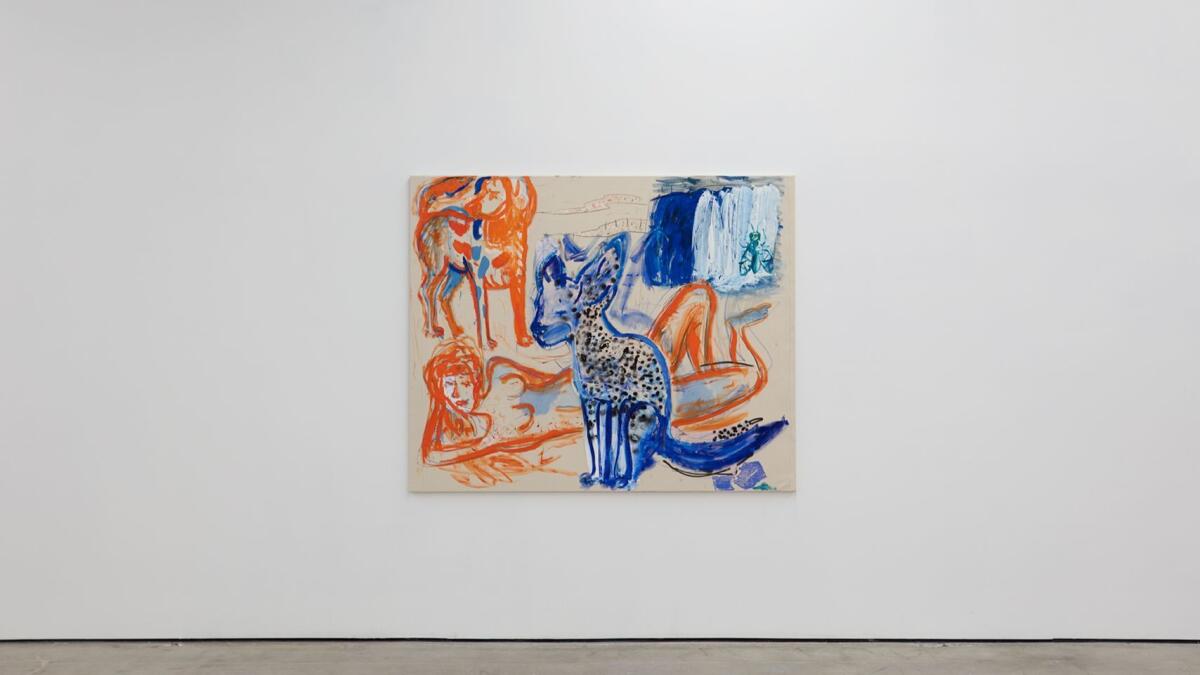
Last chance
Shagha Ariannia, “Who Sings the Nation-State?” at the Vincent Price Art Museum. The artist, who was born in Tehran, looks at issues of citizenship, national identity and immigration through the lens of her own childhood in a video piece that also features related drawings and paintings. Through Saturday. 1301 Cesar Chavez Ave., East Los Angeles, vincentpriceartmuseum.org.
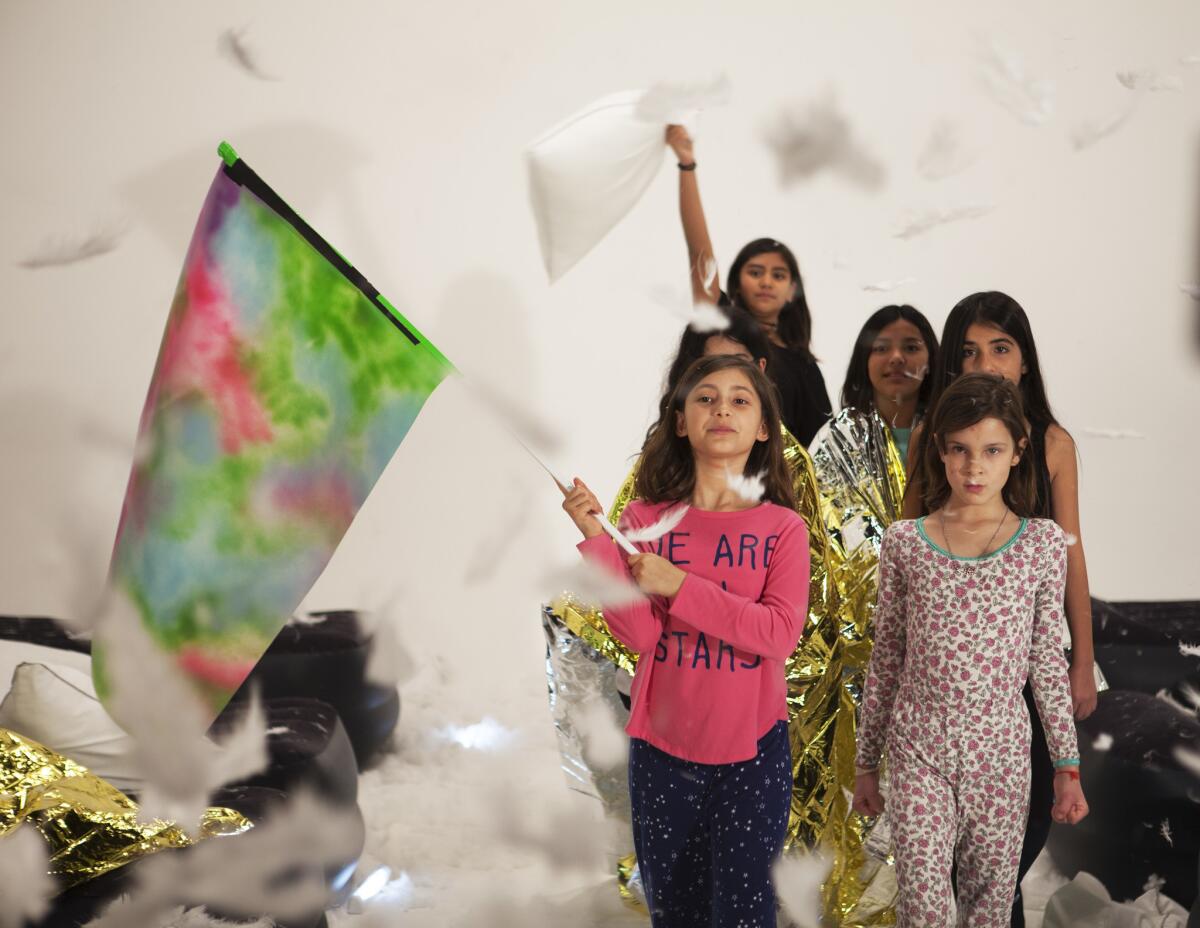
Young Joon Kwak, “Hermy,” and Patricia Fernández, “Box: a proposition for ten years,” at Commonwealth & Council. The gallery has a pair of new shows on view. The first features the sculptures and installations of Kwak, an artist who remakes everyday objects in visceral ways, and for this exhibition is inspired by the herma statues of antiquity, which generally consist of a head atop a column that bears genitalia. Fernández, in the meantime, is displaying a sculpture inspired by the history of Ruedo Ibérico books, a publishing company that served as a point of resistance to the dictatorship of Francisco Franco. Through Saturday. 3006 W. 7th St., #220, Koreatown, Los Angeles, commonwealthandcouncil.com.
Todd Eberle, “Empire of Space,” at Wuho Gallery. The architectural photographer was recently awarded the 2017 JSI Excellence in Photography Award from Woodbury University and this exhibition gathers samples of his work. Based in New York, Eberle is known for producing images that are clean and minimal — a figure who began to draw attention after shooting Donald Judd’s art and furniture in Marfa, Texas, in the 1990s. Through Sunday. 6518 Hollywood Blvd., Hollywood, wuho.architecture.woodbury.edu.
Paul Davies, at the Fitzpatrick-Leland House. The historic Rudolph Schindler-designed home serves as the site of a special installation by Australian-born L.A.-based Davies, a painter and sculptor who is known for his stark portraits of Modern architecture. The pieces will be available for sale — and a portion of the proceeds will go towards restoration costs for the early Modern home, which was completed in 1936. Through Sunday; by appointment only. 8078 Woodrow Wilson Ave., Hollywood Hills, Los Angeles, makcenter.org.
Ongoing exhibitions
“L.A. 92: Decompressing History,” at Jean Deleage Gallery at Casa 0101. The 1992 L.A. uprising was recorded by countless professional photographers. It was also captured by everyday people wielding a camera. This exhibition gathers the images of L.A. resident Armando Cabrera, who was 24 when the riots unfolded in Los Angeles and captures the manifold moments of drama between the city’s residents and law enforcement. Through June. 2102 E. 1st St., Boyle Heights, Los Angeles, casa0101.org.
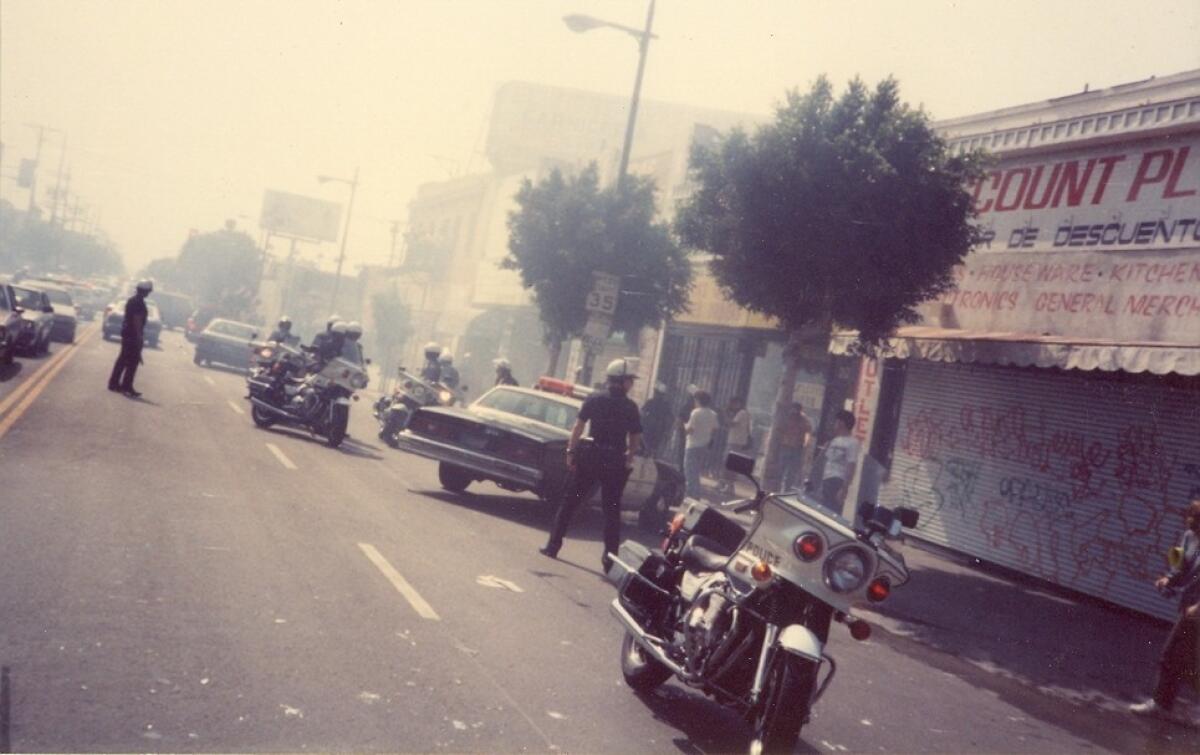
Duke Choi, “The Kim Sangdon Project,” at the Korean Resource Center. An eight-channel video installation pays tribute to Kim Sangdon, the first democratically elected mayor of Seoul, who was later jailed following a military coup. In exile, he remained involved in struggles for democracy in his native Korea. Through June 29. 900 Crenshaw Blvd., Los Angeles, krcla.org.
Sherin Guirguis, “My Place is the Placeless,” at the 18th Street Arts Center. The L.A.-based, Egyptian-born artist, who was recently part of the Desert X biennial in the Mojave, is currently in residence at the 18th Street Arts Center. On view is an installation that that comments on issues of displacement and environmental destruction, but in ways that fuse Western Modernism with Eastern architectural and design elements. Through June 30. 1639 18th St., Santa Monica, 18thstreet.org.
Lezley Saar, “Gender Renaissance,” at Walter Maciel Gallery. The Los Angeles artist creates paintings that hark back to Victorian styles (she often employs an oval format and places her work in antique frames) but adds flashes of the surreal and the contemporary. Her latest series looks at the complex topic of gender identity, inspired by her son’s transition from female to male. Also on view will be some large-format banners that feature portraits of defiant women on backdrops of quilted patterns. Through July 1. 2642 S. La Cienega Blvd., Culver City, waltermacielgallery.com.
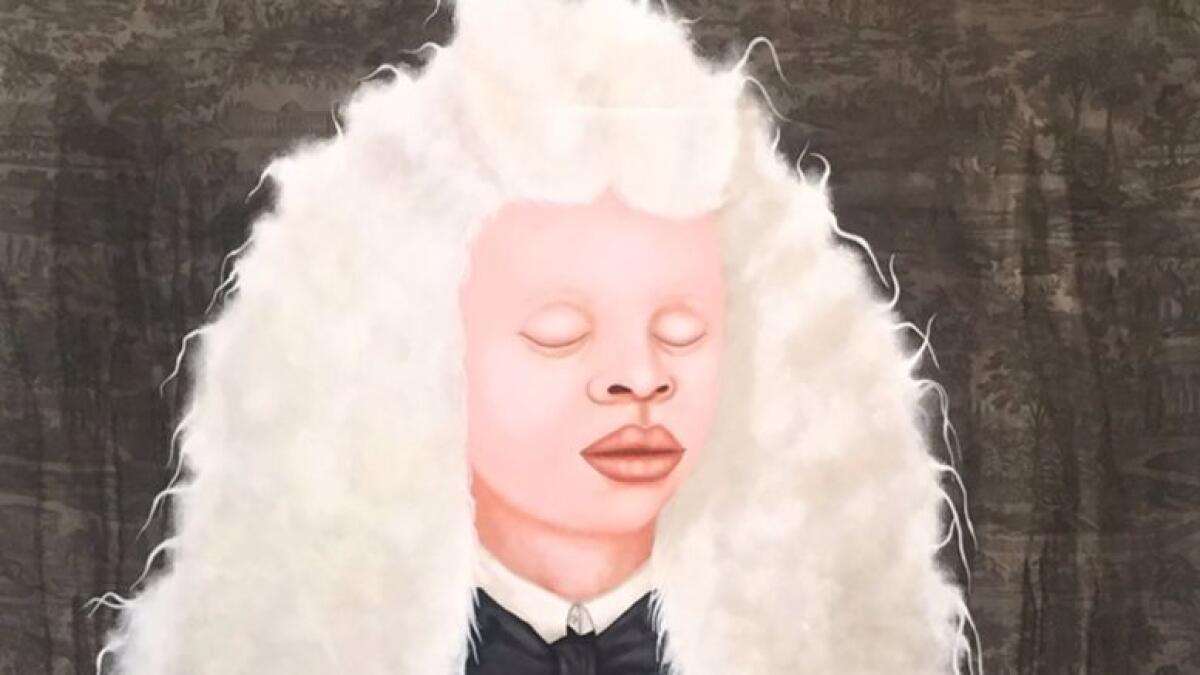
“Don Porcella: Everything Must Go,” at Noysky Projects. A site-specific installation by the New York-based artist pokes a stick at the commodification of everything, including memories. This particular show nods to its location (Noysky is located just off Hollywood Boulevard) with an installation that is inspired by the tourist memento — except in his case, Porcella has created tchotchkes inspired by personal memories and crafted them out of materials such as pipe cleaners, cardboard and puffy paint. Through July 1. 6727 ⅞ Hollywood Blvd., Hollywood, noyskyprojects.com.
“Signifying Form,” at the Landing Gallery. A beguiling exhibition organized by independent curator Jill Moniz (formerly of the California African American Museum) brings together sculpture by African American women from 1935 to the present. This puts works by esteemed figures such as Elizabeth Catlett, Betye Saar, Maren Hassinger and Senga Nengudi into an intergenerational dialogue with younger artists such as Brenna Youngblood. The show is united by a profound interest in material and its possibilities, be it wire, wood or buoyant plastic bags. Of particular interest is Alison Saar’s “Cakewalk,” a 1997 sculpture that consists of a life-size wood puppet of a black female figure — on view for the first time in Los Angeles. Viewers are allowed to move her limbs, becoming complicit in a long history of controlling black female bodies. Do not miss. Extended through July 1. 5118 W. Jefferson Blvd., West Adams, thelandinggallery.com.
Edgar Arceneaux, at Susanne Vielmetter Los Angeles Projects. This special exhibition represents the Los Angeles premiere of “Until, Until, Until….” Arceneaux’s first work of theater, the piece explores the controversial inauguration day performance by Ben Vereen, in which the actor and dancer paid tribute to vaudeville performer Bert Williams. (I wrote about it in The Times when it premiered at Performa in 2015.) It’s a short run, so don’t miss it. Also on view will be an exhibition of work by Samuel Levi Jones, who makes abstracted collages out of the fragments of books. Through July 1. 6006 Washington Blvd., Culver City, vielmetter.com.
Mai-Thu Perret, “Féminaire,” at David Kordanksy Gallery. The Geneva-born artist has created an installation inside Kordanksy Gallery that is inspired by the 1969 novel by Monique Wittig “Les Guérillères,” which tells a story of a war waged by women who are trying to take over society. The show includes a series of sculptural female warriors, as well as ceramic pieces that evoke battle memorials. Sounds like the perfect show for this political moment. Also on view will be an exhibition of 12 new paintings by Lesley Vance, whose abstracted works often hark to the annals of art history while remaining resolutely modern. Through July 1. 5130 W. Edgewood Place, Mid-Wilshire, Los Angeles, davidkordanskygallery.com.
“In Focus: Jane and Louise Wilson’s Sealander,” at the Getty Museum. For roughly three decades, twin sisters Jane and Louise Wilson have created large-scale photographs inspired by important events in European history — in the process, capturing the nuclear site at Chernobyl and the former headquarters of the East German secret police. In this series, they turn their attention to the brutal concrete bunkers deposited by Adolf Hitler along the French coast during
“Abdulnasser Gharem: Pause,” at the Los Angeles County Museum of Art. Gharem isn’t just an artist, he is also a lieutenant colonel in the Saudi Arabian army, the country where he was born and lives. His new show at LACMA, his first solo museum presentation in the U.S., brings together 11 works by the artist all made in the aftermath of Sept. 11. The work, which fuses contemporary art making styles with traditionally Islamic motifs, quietly ruminates on the nature of war and terror (two of the artist’s former classmates were hijackers). Through July 2. 5905 Wilshire Blvd., Mid-Wilshire, Los Angeles, lacma.org.

“Peter Shire: Naked Is the Best Disguise,” at the Museum of Contemporary Art. This survey looks at the work of the L.A.-based Shire, a key figure in Southern California’s “post-pottery” ceramics movement. The exhibition will display key work he did in the postmodern vein as part of Memphis, the Milan-based design collective — a group whose work was all about elaborate juxtapositions of bright colors and wild shapes. Also on view will be the artist’s handmade ceramic earthenware, crafted under the label Echo Park Pottery, and the work for which he is best known. Through July 2.
Kerry James Marshall, “Mastry,” at the Museum of Contemporary Art. A 35-year retrospective, featuring nearly 80 works, examines the career of a painter who is known for depicting the black figure in ways that are mordant, lordly and defiant — as well as painterly in the most sublime ways. Born in Birmingham, Ala., but raised in L.A. during the civil rights and black power movements, Marshall paints historical events, the city (including bits of Los Angeles), domestic scenes and portraits in ways that counter the invisibility of the black figure in Western art. His people — rendered in the inkiest shades of black — command notice and authority. Consider this show a must-see. Through July 3. MOCA Grand Avenue, 250 S. Grand Ave., downtown Los Angeles, moca.org.
Pop-Up Studio: Michael Parker, “The Ides: Radical Cartography,” at the Palm Springs Art Museum. This exhibition is inspired by the L.A. artist’s long-running project “The Ides.” The current iteration takes a cardboard sculpture that framed the Port of Los Angeles last year and reconfigures it into a series of plinths used to display 39 ceramic sculptures and their robotically carved replicas. Various collaborators have interpreted these in myriad ways. Through July 5. 101 Museum Drive, Palm Springs, psmuseum.org.
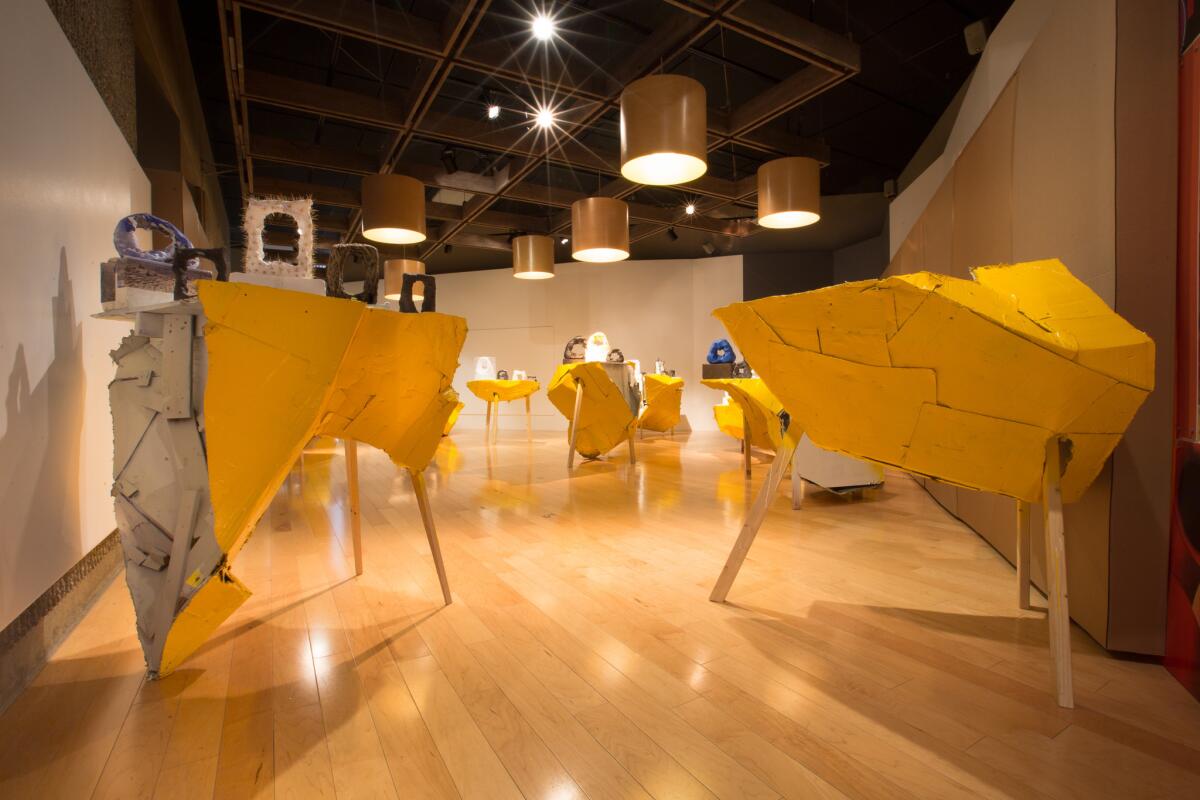
Richard Hamilton, Carlo Mollino and John Stezaker, “Blackout,” at Ibid Los Angeles. A new exhibition at Ibid brings together the works of three artists known for creating collages out of appropriated materials, be it a poster or pieces of photography. The show focuses on works that employ the human figure as a model in advertising, exploring questions of iconography, idealized beauty and consumerism. Also on view will be paintings by Christopher Orr and assemblages from the studio of James Herman. Through July 8. 670 S. Anderson St., Boyle Heights, Los Angeles, ibidgallery.com.
“Focus Group,” at Charlie James Gallery. Artist Michael Shaw, who hosts the arts podcast “The Conversation,” has put together a group show inspired by curator and author Nato Thompson’s book “Seeing Power,” which notes that art is either “ambiguous” or “didactic.” Shaw has put together works that riff on these ideas — but by placing these works in close proximity with one another, he warps and changes their meanings. Through July 8. 969 Chung
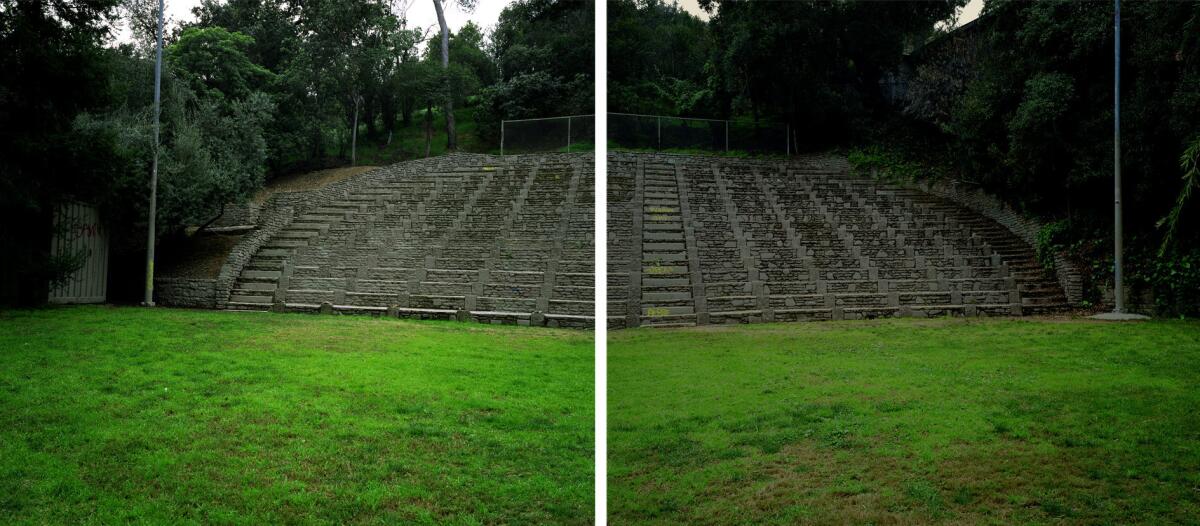
“The Inner Eye: Vision and Transcendence in African Arts,” at LACMA. A display of African art gathers objects that touch on important life transitions: initiation pieces, iconic masks and the reliquary guardians that guide people into the afterlife. The works on view, which include metalwork, sculpture and textiles, date from the 13th to 19th centuries and cover various African regions, including Mali, Nigeria, Liberia and Congo. Through July 9. 5905 Wilshire Blvd., Mid-Wilshire, Los Angeles, lacma.org.
John Baldessari, “Eight Colorful Inside Jobs,” at Mixografia. This exhibition features works from the more than two-decade-long collaboration between the renowned California conceptualist and the innovative printers at Mixografia, known for creating paper works with deep texture (or illusions of texture). The series on view presents shapes in simple forms in solid basic colors. Through July 15. 1419 E. Adams Blvd., Central-Alameda, Los Angeles, mixografia.com.
An Te Liu, “Transmission,” at Anat Ebgi. Liu is a Toronto-based artist whose bronze and ceramic works are carved and cast from mundane materials such as plastic foam. His first solo show at Anat Ebgi gathers a number of his trophy-like works. Through July 15. 2660 S. La Cienega Blvd., Culver City, anatebgi.com.
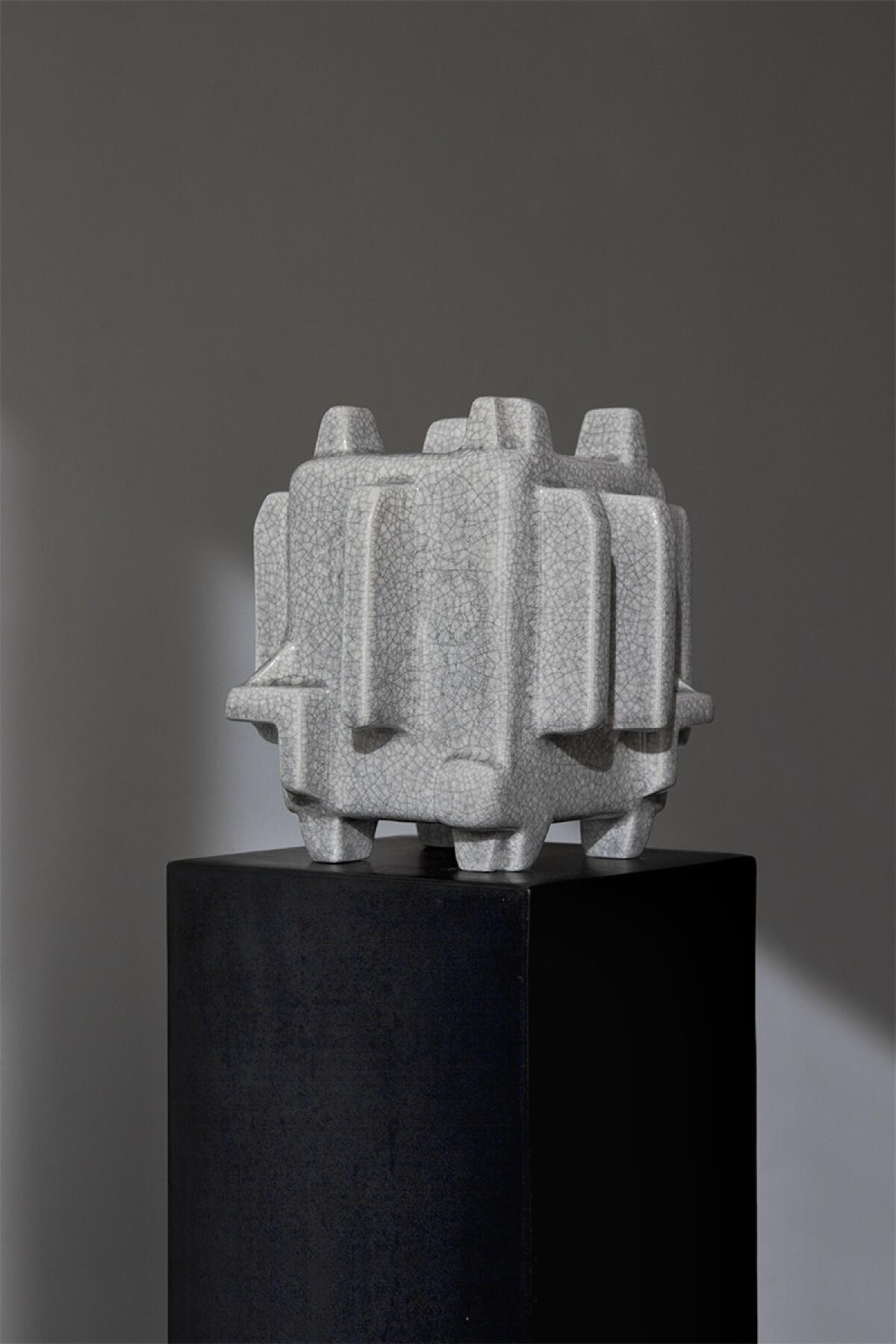
“Vernacular Environments, Part 1,” at Edward Cella Art & Architecture. A group show brings together works from the 1960s to the present in ways that explore issues of environment and the ways in which humans shape it. Serving as a cornerstone to the exhibition is Robert Smithson’s film “Spiral Jetty,” about his renowned piece of land art of the same name. Other artists in the show include sculptor Dan Graham, composer and video artist Christian Marclay, photographer Stephen Berens and conceptualist Clarissa Tossin, who created a floating sculpture based on Brazil’s presidential palace out of empty cement bags, a nod to the Brazilian capital’s informal settlements. Through July 15. 2754 S. La Cienega Blvd., Culver City, edwardcella.com.
Hammer Projects: Andrea Bowers, at the Hammer Museum. Bowers, an artist known for her activism, regularly broaches the subject in her work. This new installation was inspired by the artist’s involvement in the protests at Standing Rock — charting the connections between the international banking system and the construction of oil pipelines. She ties these to food and water issues at the Los Angeles level. Through July 16. 10899 Wilshire Blvd., Westwood, Los Angeles, hammer.ucla.edu.
“Chinese Ceramics From the Los Angeles County Museum of Art,” at the Vincent Price Art Museum.” Part of a new series of partnerships that will take LACMA works to other organizations around L.A., this show represents an overview of Chinese ceramics from the museum’s permanent collection that take the viewer from circa 2500 BC to the 19th century — as well as the museum’s own long history as a collector of Chinese ceramics. Through July 22. East Los Angeles College, 1301 Cesar Chavez Ave., Monterey Park, vincentpriceartmuseum.org and lacma.org.
“A Decolonial Atlas: Strategies in Contemporary Art of the Americas,” at the Vincent Price Art Museum. A group exhibition looks at the legacy of colonialism in everything from historical narratives to the struggle over human resources. The show is broken up into four sections that provide a distinctly indigenous view of identity, notions of time, relationship to the landscape (and the resources they hold) and how history is told and archived. Sounds like a show for our time. Through July 22. East Los Angeles College, 1301 Cesar Chavez Ave., Monterey Park, vincentpricemuseum.org.
Star Montana, “I Dream of Los Angeles,” at the Main Museum. Montana is an artist known for her stark, formally posed photographic portraits — a style she employs on the everyday denizens of Los Angeles, including people she meets on the streets in her native Boyle Heights as well as others that she has met through open calls. This show gathers various new works. The museum will also have an exhibition devoted to Alice Könitz’s prototypes for new types of museum seating. Through July 23. 114 W. 4th St., downtown Los Angeles, themainmuseum.org.
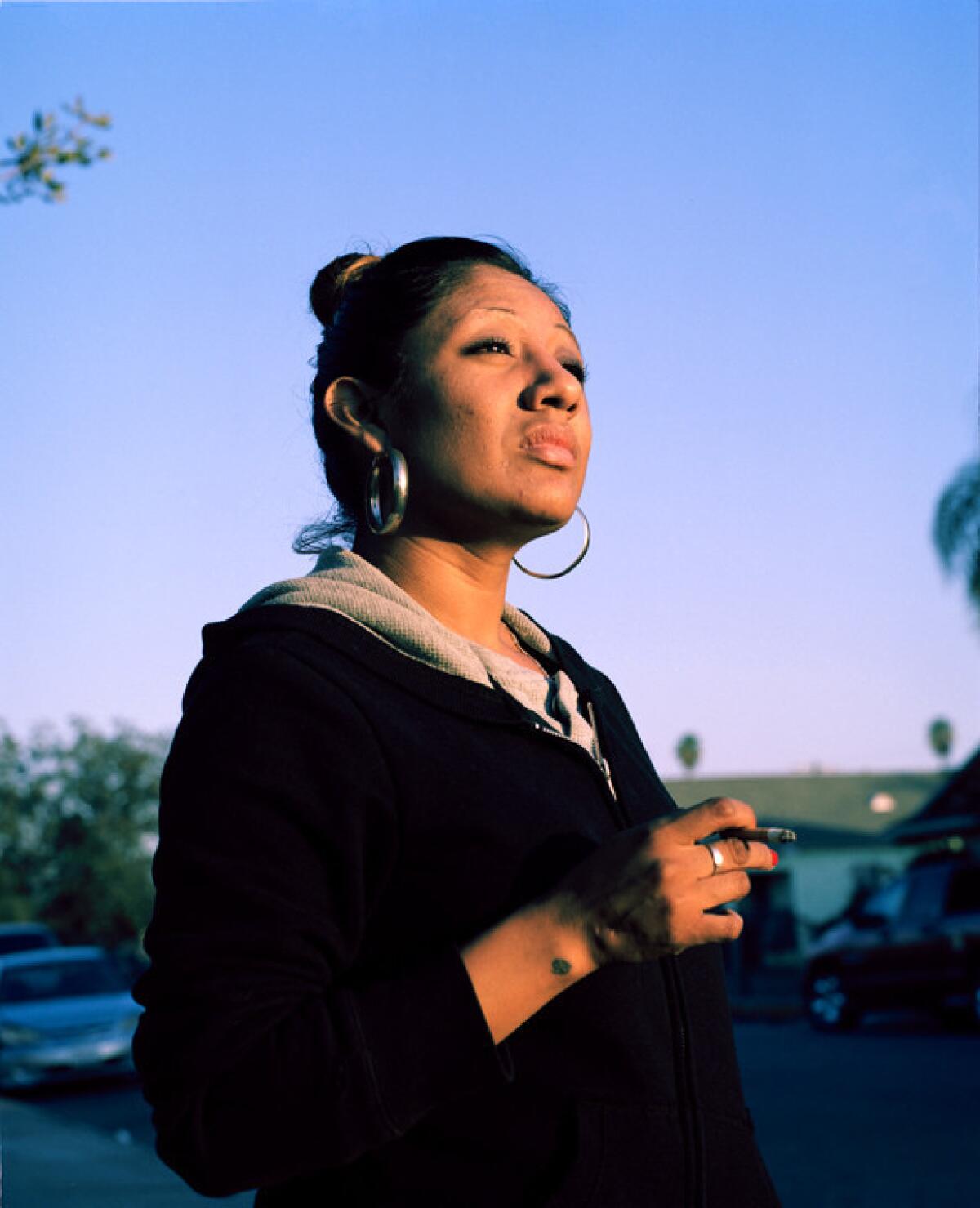
Carl Andre, “Sculpture as Place: 1958-2010,” at the Museum of Contemporary Art. This retrospective, which was first shown at Dia:Beacon in 2014, surveys the work of a sculptor known for creating minimalist installations out of raw building materials such as bricks, metal squares and wood blocks. The retrospective brings together pieces from throughout the artist’s five-decade career, including sculpture, photography, ephemera and his rare “Dada Forgeries,” a series of ready-made pieces that he has produced sporadically over the course of his life. Also opening at MOCA Geffen is a new film installation by award-winning filmmaker and artist Arthur Jafa, which traces questions of black identity employing found footage. Through July 24. 152 N. Central Ave., downtown Los Angeles, moca.org.
“Spiral Play: Loving in the ’80s,” at Art + Practice. Al Loving was an artist who drew on sources as varied as free jazz, his family’s quilting traditions and the history of Modern painting when creating abstracted works that riffed on color, form and flatness. But later in life, he turned his attention to depth, using heavy rag paper and other elements to create multidimensional collages infused with bold lines and bright color. This show, organized by Christopher Bedford, the new director of the Baltimore Museum of Art (formerly of LACMA), features 12 of these late monumental collages. Through July 29. 3401 W. 43rd Place, Leimert Park, Los Angeles, artandpractice.org.
“Concrete Poetry: Words and Sounds in Graphic Space,” at the Getty Research Institute. This is an exhibition where words are about words, but also form. Starting in the mid-1950s, the movement known as concrete poetry sought to explore the space between poetry and visual art, creating works that were visual (words in shapes and 3-D form) but also played with the sound and cadence of language. This show features more than 100 works from the lead poets of the era, including Scotsman Ian Hamilton Finlay, the Brazilian Augusto de Campos and U.S. poets Mary Ellen Solt and Emmett Williams. Through July 30. 1200 Getty Center Drive, Brentwood, Los Angeles, getty.edu.
“From the Desert to the Sea: The Desolation Center Experience,” at Cornelius Projects. Today, we have Coachella. In the early ’80s, there was Desolation Center, a series of site-specific concerts held in the desert that were a little bit DIY and a lot of punk. (Audiences would arrive by rented school bus. No one Instagrammed.) Key musicians included Sonic Youth, Meat Puppets and Einstürzende Neubauten, and on-site art was provided by the likes of Survival Research Laboratories. This exhibition at Cornelius Projects features painting, photography, sculpture and other ephemera related to the shows. Through July 30. 1417 S. Pacific Ave., San Pedro, corneliusprojects.com.

“Eyewitness News: Making History in Eighteenth-Century Europe,” at the Getty Museum. In the days before smartphones and cameras and even the daguerreotype, important public events were recorded through painting. This newly-opened show at the Getty has gathered works by the likes of Antonio Canaletto, Bernardo Bellotto, Giovanni Paolo Panini and others that record the important events of the era: a state visit between a king and a pope, the first hot air balloon flight ever recorded in Venice, Italy, and the damage suffered by the German city of Dresden after the Seven Years’ War of the 18th century. A new — or perhaps old? — way of looking at the news. Through July 30. 1200 Getty Center Drive, Brentwood, Los Angeles, getty.edu.
“Black Velvet Punks: Pistols to Plasmatics,” at Velveteria. The esteemed velvet painting museum has a new show up dedicated to the pioneers of punk. Rendered on seductive black velvet are important musicians such as Johnny Rotten, Henry Rollins, Wendy O. Williams and GG Allin. Plus, a special new portrait honors Rodney Bingenheimer, a.k.a. “Rodney on the ROQ,” the influential DJ who left KROQ after 40 years of giving key acts their radio breaks. Through July. 711 New High St., Chinatown, Los Angeles, velveteria.com.
“Nut Art,” at Parker Gallery. This group show harks back to a movement called Nut Art that was founded in the late ’60s by a group of Northern California artists that included painter Roy De Forest, writer David Zack and ceramicist and printmaker David Gilhooly. (The concept took off at Gilhooly’s house in Port Costa as the group was drinking beer.) A number of exhibitions brought together by these artists, whose bright, multihued pieces riffed on the humorous and the slightly surreal. The show at this new apartment gallery brings together exhibitions from a 1972 show, as well as related works by those artists. Through Aug. 5. Email [email protected] for location and hours, Los Feliz, parkergallery.com.
Joe Ray, “Complexion Constellation,” at Diane Rosenstein Gallery. An exhibition by the L.A.-based artist brings together works from throughout his five-decade career exploring “inner and outer space.” This includes works made from resin and plastic about issues of depth and perception (he was connected to important light and space figures such as Larry Bell), as well as canvases that depict aspects of outer space and, with wryly written words, connect with issues of race. Other ephemera — such as photographs from early performances — are included. Through Aug. 5. 831 N. Highland Ave., Hollywood, dianerosenstein.com.
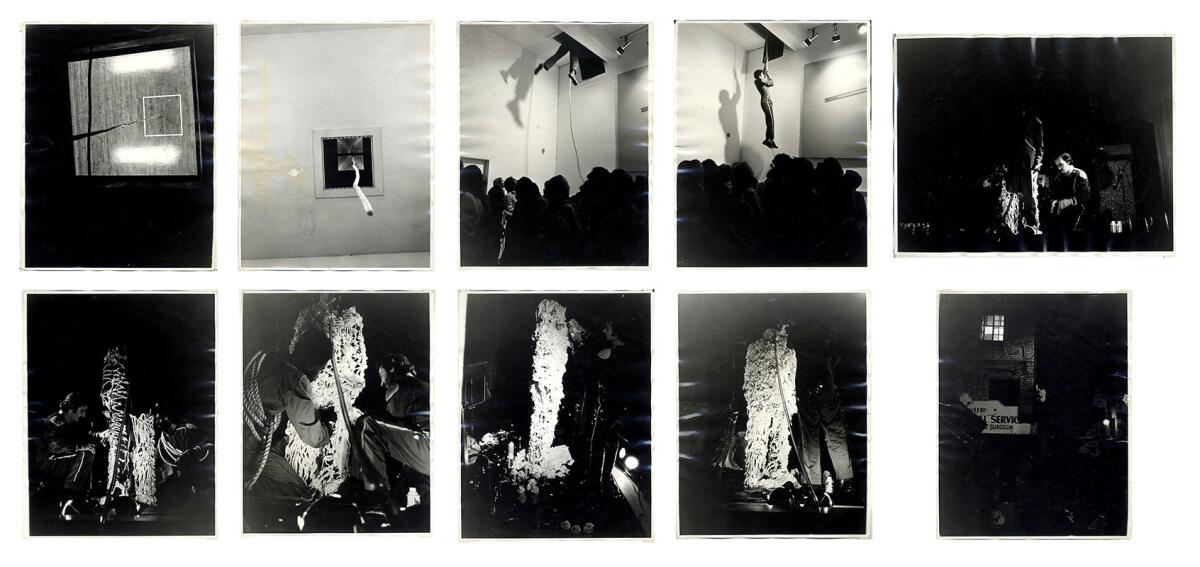
“Flaming June VII (Flaming Creatures),” at Gavlak Gallery. Part of a series of shows that Sarah Gavlak has organized since 1997, this group exhibition, featuring work by Lisa Anne Auerbach, Marnie Weber, Betty Tompkins and Lecia Dole-Recio, takes its inspiration from the 19th century English painter Frederic Leighton’s “Flaming June,” an 1895 canvas of a sleeping woman in a brilliant orange gown. Through Aug. 5. 1034 N. Highland Ave., Hollywood, gavlakgallery.com.
“Octavia E. Butler: Telling My Stories,” at the Huntington. Butler, the pioneering Los Angeles science fiction writer (the first to receive a MacArthur Fellowship, the so-called genius grant) and a writer whose narratives seamlessly blended issues of race and gender with elements of the magical, is the subject of a new exhibition on her life and work. This show at the Huntington (where her archive is kept) gathers roughly 100 items, including notebooks, photographs, journals and first editions of some of her novels, including “Kindred,” one of her best, most riveting works. Through Aug. 7. 1151 Oxford Road, San Marino, huntington.org.
Andrea Zittel, at Regen Projects. Zittel is perhaps best known for creating the High Desert Sites in Joshua Tree, an arts compound that is as much a gathering space as it is an ever-evolving work of art that she also inhabits. This show continues her investigations into the ways in which environment can be shaped and molded in ways that are both industrial and domestic. It also marks the inauguration of a new sculptural work in the desert. Through Aug. 12. 6750 Santa Monica Blvd., Hollywood, regenprojects.com.
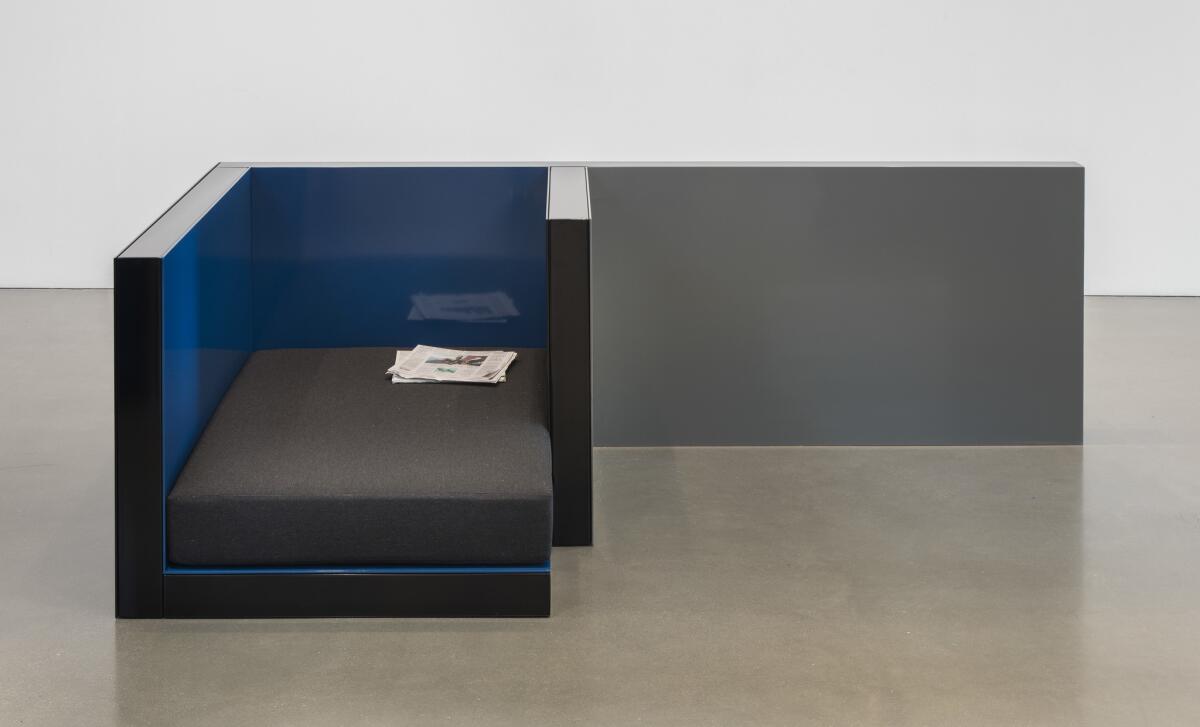
“Instructions to All Persons: Reflections on Executive Order 9066,” at the Japanese American National Museum. At a time when executive orders are transforming U.S. society, it’s a good moment in which to study one of the most notorious ones: President Franklin D. Roosevelt’s Order 9066, which allowed for the incarceration of more than 120,000 Japanese Americans living along the West Coast during World War II. This exhibition brings together historical ephemera from this dark period in U.S. history, as well as works of art and performance that reflect on the issue of internment. Along with this, the museum is presenting “Moving Day,” a nightly public art piece in which exclusion orders are projected on the side of the building. Through Aug. 13. 100 N. Central Ave., downtown Los Angeles, janm.org.
“Now Then: Chris Killip and the Making of In Flagrante,” at the Getty Museum. This exhibition features work from Killip’s groundbreaking book, “In Flagrante,” which documented the impact of deindustrialization on working-class communities in northern England in the 1970s and ’80s. The show includes maquettes, contact sheets and work prints, as well as images form a pair of related projects. A moving ode to industrial towns in decline. Through Aug. 13. 1200 Getty Center Drive, Brentwood, Los Angeles, getty.edu.
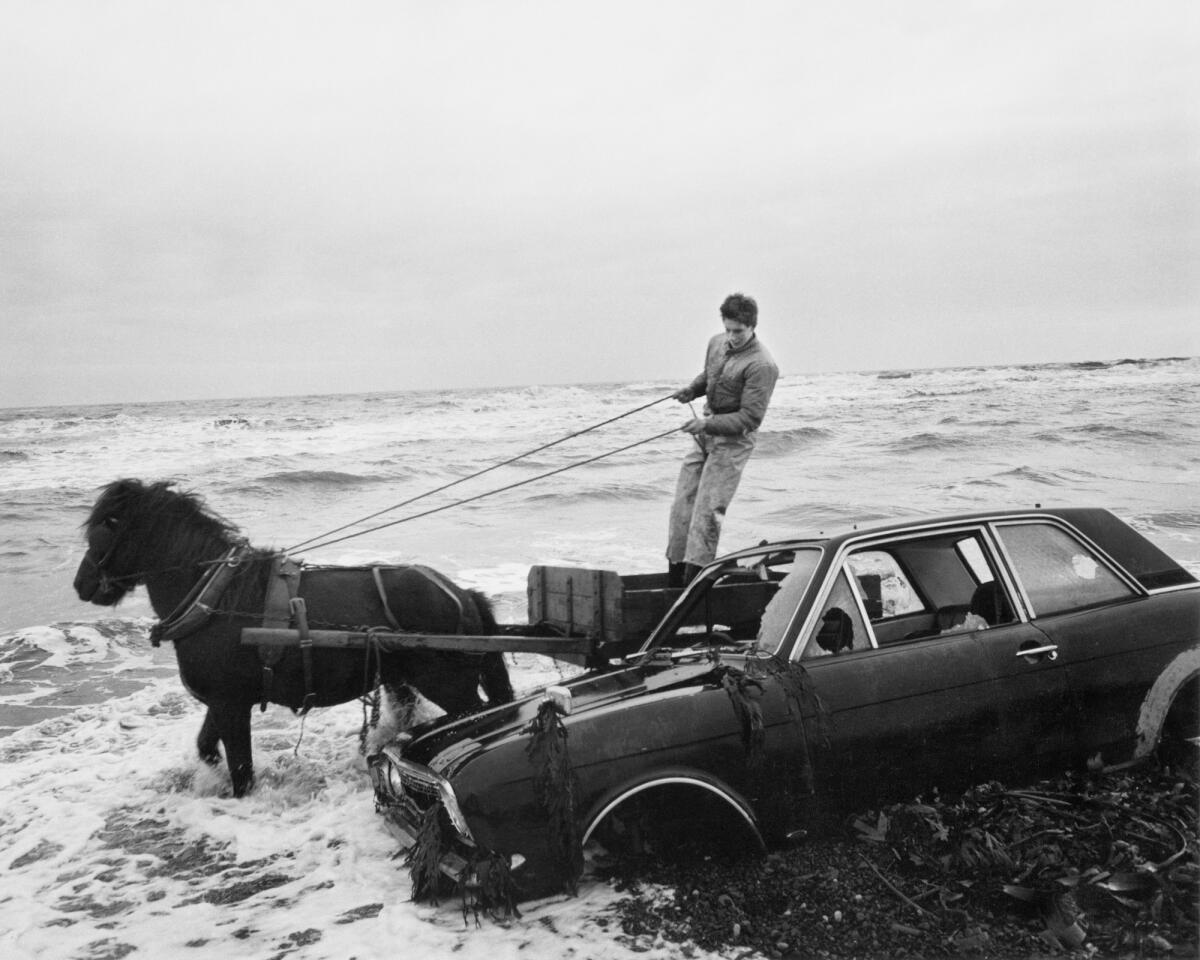
Lucio Muniain, “Are You Skeptical?” at the Grand Central Art Center. The Mexico City artist takes everyday images of brutality that saturate the media and uses them to create works on paper that record, in a more methodical fashion, the issues of violence plaguing the poor, migrants and marginalized communities — a way of re-sensitizing viewers who might be numb to the daily drumbeat of bad news. As part of the exhibition, which will feature dozens of the artist’s drawings, Muniain has also created a large-scale mural. Through Aug. 13. 125 N. Broadway, Santa Ana, grandcentralartcenter.com.
Lauren Greenfield, “Generation Wealth,” at the Annenberg Space for Photography. Greenfield, a filmmaker and photographer, has long explored the issues of affluence and consumerism at the intersection of social status and celebrity culture. The exhibition features 195 color prints that depict the continual aspiration for more. Through Aug. 13. 2000 Avenue of the Stars, Century City, Los Angeles, annenbergphotospace.org.
Marisa Merz, “The Sky is a Great Space,” at the Hammer Museum. This is the first traveling U.S. retrospective of the Italian painter, sculptor and installation artist, covering five decades of innovative work — from her early experiments with Arte Povera (the only female member of the movement) to the enigmatic heads she created in the 1980s and ’90s. The show will include some of her trademark installations from the ’70s too — including pieces made from delicate copper wire, bowls of saltwater and knitting needles. This is the exhibition’s West Coast debut after its display at the Met Breuer in New York City. Through Aug. 13. 10899 Wilshire Blvd., Westwood, hammer.ucla.edu.
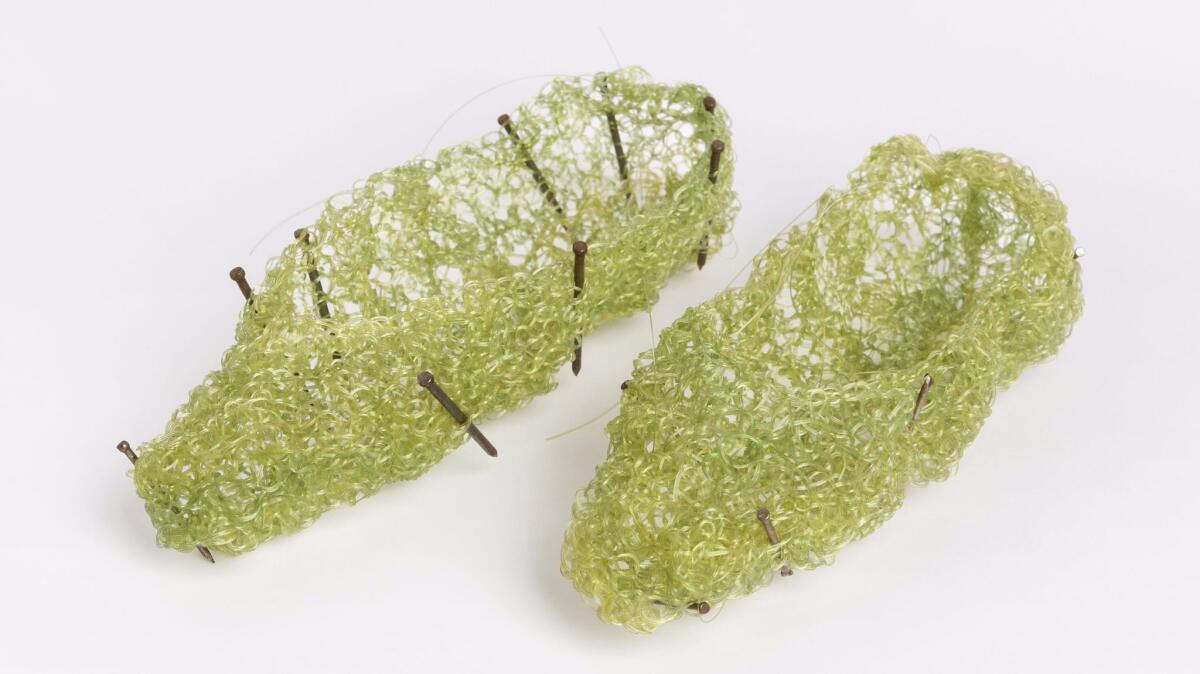
Betye Saar, “Keepin’ It Clean,” at the Craft & Folk Art Museum. A new exhibition by the renowned Los Angeles assemblage artist gathers the washboard pieces that she has made over the course of her career — pieces that reflect on issues of American race and inequity. Also on view is the exhibition “Material as Metaphor,” which features nearly a dozen artists exploring contemporary iterations of fiber art using materials such as vinyl, industrial felt and wire. Through Aug. 20. 5814 Wilshire Blvd., Mid-Wilshire, Los Angeles, cafam.org.
“Chalk Circles,” at REDCAT. A combination of art and performance explores the connection between the two — including the ways in which these forms address movement and gesture and the presence of bodies. The show is organized by REDCAT gallery director Ruth Estevez and LACMA curator José Luis Blondet, and its title is inspired by a 1944 play written by Bertolt Brecht in Los Angeles called “The Caucasian Chalk Circle.” The show includes work by Emily Mast, Pilar Aranda, Peio Aguirre, Dora García, Silke Otto-Knapp and Kerry Tribe. Through Aug. 20. Check the website for a full list of performances. 631 W. 2nd St., downtown Los Angeles, redcat.org.
“No Justice, No Peace: LA 1992,” at the California African American Museum. A historical exhibition looks at the myriad social and political forces that led to the 1992 riots in the wake of the Rodney King verdict — including a troubled history of police relations in minority communities, a history of housing segregation and the drug war, among other factors. Included in the show are hundreds of images and historic documents, as well as a zoot suit and a ’90s era police cruiser. Through Aug. 27. 600 State Drive, Exposition Park, Los Angeles, caamuseum.org.
“NOEMA,” at the El Segundo Museum of Art. A show about diagramming features at its heart an epic 27-foot piece by Matthew Ritchie that was created in collaboration with the Getty Research Institute and charts the entire history of human diagrams. This was obviously designed for a geek like me. Through Aug. 27. 208 Main St., El Segundo, esmoa.org.
“Living Apart Together: Recent Acquisitions,” at the Hammer Museum. A new installation gathers recent additions to the museum’s permanent collection — gifts from donors and artists, as well as museum acquisitions — with an emphasis on art made over the last decade in Los Angeles. A good opportunity to see what’s been cooking in the old hometown. Through Aug. 27. 10899 Wilshire Blvd., Westwood, Los Angeles, hammer.ucla.edu.
“Frida Kahlo: Through the Lens of Nickolas Murray,” at the Museum of Latin American Art. For almost a decade in the 1930s and ’40s, the Hungarian-born photographer Nickolas Murray photographed Mexican painter Frida Kahlo at home and at work. This exhibition gathers 46 black and white and color photographs of the Mexican artist, as well as copies of the correspondence they exchanged. Through Sept. 3. 628 Alamitos Ave., Long Beach, molaa.org.
2017 California Pacific Triennial, at the Orange County Museum of Art. The latest iteration of OCMA’s biennial looks at issues of architecture and urban design and their ever evolving features. This includes installations by 25 artists from throughout the Pacific Rim, including L.A.-based artist Olga Koumoundouros, known for working with fallow structures; Nancy Popp, who has studied issues of displacement related to the Olympics in Rio de Janeiro; Korea-born artist Haegue Yang, who employs elements of domestic architecture in elaborate installations; and Teddy Cruz, of Estudio Teddy Cruz, in collaboration with Fonna Forman, both of whom run the Cross-Border Initiative at UC San Diego. At a time in which space in cities is growing increasingly contested, it is an ideal time for a show of this nature. Through Sept. 3. 850 San Clemente Drive, Newport Beach, ocma.net.
Luis Tapia, “Cada Mente es un Mundo,” at the Museum of Latin American Art. This solo presentation features new and recent works by the Santa Fe-based artist, who is known for creating work that is inspired by the techniques of traditional craft — but uses it to address a range of modern themes, including Chicano identity. Through Sept. 3. 628 Alamitos Ave., Long Beach, molaa.org.
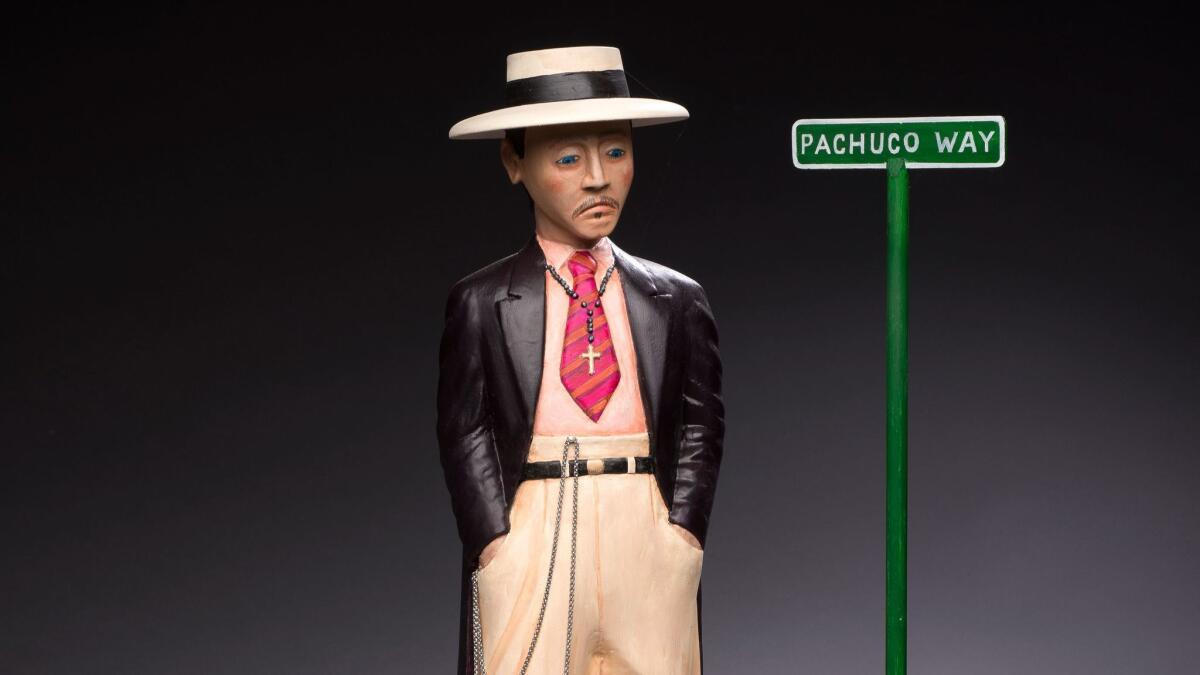
“Los Angeles to New York: Dwan Gallery, 1959-1971,” at the L.A. County Museum of Art. Previously on view at the National Gallery of Art in Washington, this exhibition tracks the legacy of one of the most important postwar galleries in the United States — a space that, for a time, operated in Los Angeles. Its proprietor, Virginia Dwan, wasn’t simply a run-of-the-mill gallerist, she was a patron, supporting artists with stipends and studios. She staged one of the earliest pop art exhibitions and she was an important supporter of minimalism. Plus, she was key in helping artists execute the most outrageous works — including important land art pieces such as Robert Smithson’s “Spiral Jetty.” Talk about thinking big. Through Sept. 10. 5905 Wilshire Blvd., Mid-Wilshire, www.lacma.org.
Jim Shaw, “The Wig Museum,” at Marciano Art Foundation. Shaw is a Los Angeles artist who has long been obsessed with marginal religious movements and secretive social orders. Which makes him the perfect artist to take over the cavernous theater at the Marciano Art Foundation, which once served as a masonic temple. (Among the various collections in his studio, Shaw maintains a box of masonic wigs.) For this installation, he has employed vintage masonic theater backdrops that were found at the space for a sprawling diorama that riffs on the themes that preoccupy him most: capitalism and its discontents. Also on view is an exhibition of works from Marciano’s private collection. Through Sept. 17. Admission is free but advance reservations are required. 4357 Wilshire Blvd., Windsor Square, Los Angeles, marcianoartfoundation.org.

“Down and to the Left: Reflections of Mexico in the NAFTA Era,” at Armory Center for the Arts. A group exhibition featuring work by a range of Mexico and U.S-based artists takes as its point of departure the ’90s NAFTA years, a period of great change, when Mexico came out of a relative period of isolation, and when the local and the global became one. It was also a time when the Zapatista rebellion against the government had galvanized indigenous people and international audiences. Many of the works on view by artists such as Javier Téllez, Nao Bustamante, Lourdes Grobet and Pedro Mayer deal with this climate of economic and political unrest. Through Sept. 17. 145 N. Raymond Ave., Pasadena, armoryarts.org.
“Maven of Modernism: Galka Scheyer in California,” at the Norton Simon Museum. This exhibition examines the life of a key art dealer: Galka Scheyer, who embraced Modern work early in the 20th century and was partly responsible for bringing the artists known as the “Blue Four” to prominence in the United States. (They were Lyonel Feininger, Alexei Jawlensky, Paul Klee and Vasily Kandinsky.) Born in Germany in the late 19th century, she ultimately settled in California, where she lived in San Francisco and later in Hollywood, where she found an audience that was open to the work and its ideas. The exhibition contains work by the Blue Four, but also objects and other artworks that connect to Scheyer’s personal and professional life. Through Sept. 25. 411 W. Colorado Blvd., Pasadena, nortonsimon.org.
“Home — So Different, So Appealing,” at the Los Angeles County Museum of Art. This is the first of the Getty-funded Pacific Standard Time: Los Angeles / Latin America series — and it couldn’t land at a better social and political moment. The show, a collaborative effort between LACMA, the Museum of Fine Arts Houston and UCLA’s Chicano Studies Research Center, thoughtfully explores the way in which Latino and Latin American artists have used elements of the domestic to comment on issues of the personal and the political in art. The assembled works — by figures such as Felix Gonzalez Torres, Luis Camnitzer and Leyla Cardenas — include installations that ruminate on immigration, urban architecture, control and subtle resistance. The conversation piece? Perhaps Daniel Joseph Martinez’s recreation of a spliced Unabomber cabin painted in Martha Stewart shades. Through Oct. 15. 5905 Wilshire Blvd., Mid-Wilshire, Los Angeles, lacma.org.
“¡Mírame! Expressions of Queer Latinx Art,” at La Plaza de Cultura y Artes. A group show brings together artists from various Latino backgrounds who explore issues of sexuality and identity in their art, including Xandra Ibarra, Alma Lopez, Julio Salgado and noted photographer Laura Aguilar, known for the striking portraits she creates of herself and others. Through Dec. 9. 501 N. Main St., downtown Los Angeles, lapca.org.
“Neo Native: Toward New Mythologies,” at the Maloof Foundation. This exhibition features more than 40 works by 11 contemporary U.S. artists with Native American roots — including painting, photography, ceramics and more. This includes works by painter Gerald Clarke Jr., ceramicist Diego Romero, conceptual artist Cannupa Hanska Luger and photographer Cara Romero. Opens Sunday and runs through Jan. 7. 5131 Carnelian St., Alta Loma, malooffoundation.org.
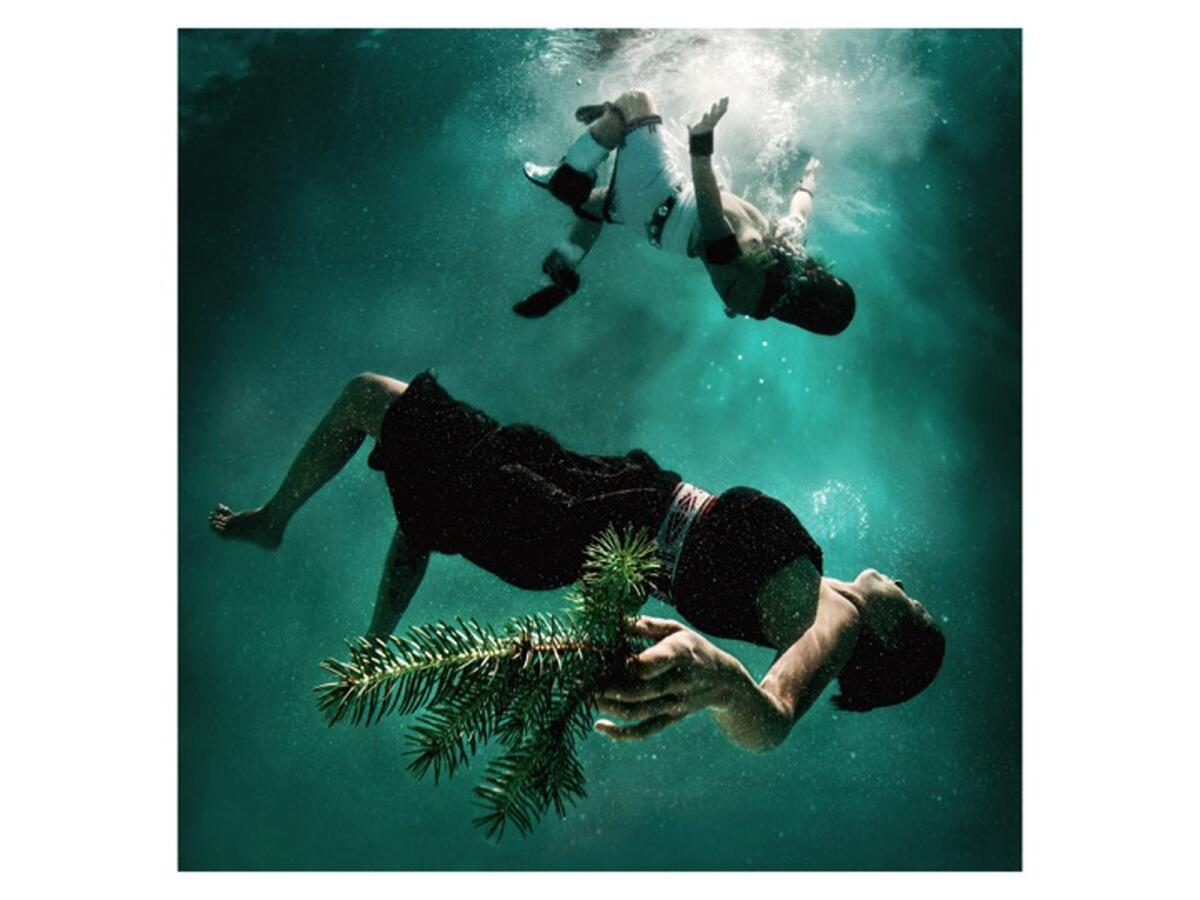
Standing Rock: Art and Solidarity, at The Autry. The Standing Rock protest in North Dakota attracted an unprecedented protest that brought together native and non-native cultures in a unified front against the proposed Dakota Access pipeline. This exhibition gathers ephemera from that action, including poster art, clothing and photographs. Through Feb. 18. 4700 Western Heritage Way, Griffith Park, Los Angeles, theautry.org.
“Artists of Color,” at the Underground Museum. As part of its ongoing partnership with the Museum of Contemporary Art, the Arlington Heights arts space has put together an exhibition that focuses on color — on its aesthetics, as well as the roles color can play as a symbol, affecting the way it’s perceived both socially and politically. The show includes works by an array of artists, including Ellsworth Kelly, Dan Flavin, Lita Albuquerque, EJ Hill, Felix Gonzalez-Torres, Josef Albers, Carmen Herrera and Noah Davis (the late founder of the Underground Museum). It’s a striking look at color seen anew. On long-term view; no closing date set. 3508 W. Washington Blvd., Arlington Heights, theunderground-museum.org.
“Becoming America: Highlights From the Jonathan and Karin Fielding Collection,” at the Huntington Library. The Huntington has just redone its American art galleries and now features a new expansion by architects at Frederick Fisher and Partners that adds eight rooms for display. Up first is an exhibition devoted to the Fielding Collection, featuring more than 200 works of 18th and early 19th century American art, including paintings, furnishings and decorative art. Through Oct. 28, 2019. 151 Oxford Road, San Marino, huntington.org.
Sign up for our weekly Essential Arts & Culture newsletter »
Twitter: @cmonstah
The biggest entertainment stories
Get our big stories about Hollywood, film, television, music, arts, culture and more right in your inbox as soon as they publish.
You may occasionally receive promotional content from the Los Angeles Times.








